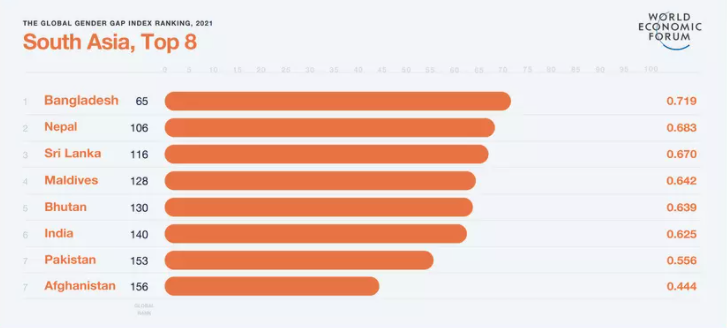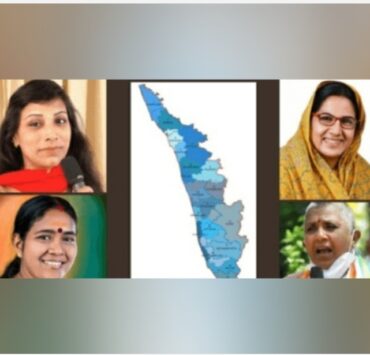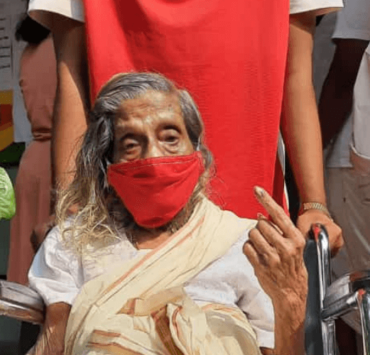
By Editors

Two important reports related to gender equity and participation in economic and public life can shed some light on what women politicians face in the battlefield that is the political arena in India today.
The 28-point downgrade of India’s ranking in the World Economic Forum’s Global Gender Gap Report 2021, published on 31 March 2021, should come as no surprise. It is merely one more symptom of the deeply entrenched inequity and push back that women in India face in public life. (The gender gap is the difference between women and men as reflected in social, political, intellectual, cultural, or economic attainments or attitudes. The Global Gender Gap Index aims to measure this gap in four key areas: health, education, economics and politics.)
India has a 62.5% gender gap, down from 66.8% in 2020. In that year’s index, the country had ranked 112th among 153 countries. With a rank of 140 in the 2021 report, India now ranks lower than its South Asian neighbours Bangladesh, Nepal, Bhutan and Sri Lanka, with only Pakistan and Afghanistan ranked below India.

While the economic gap persists, with women earning less than men, significantly, the gender gap in political empowerment continues to be the largest of the four gaps tracked. Only 22% of the gap has been closed to date, having further widened since the 2020 edition of the report by 2.4 percentage points. Across the 156 countries covered by the index, women represent only 26.1% of some 35,500 parliament seats and just 22.6% of over 3,400 ministers worldwide.
In India, which has regressed 13.5% points to reach a level of gap closed to date of just 27.6%, “The main change that took place this year is the significant decline in the share of women among ministers, which halved, from 23.1% in 2019 to 9.1% in 2021,” says the report.

Given the intimidation, misogyny and downright harassment of women in politics and others who dare to enter the public arena, the abysmal figures are only to be expected.
And this brings us to the second report. “Troll Patrol India: Exposing Online Abuse Faced by Women Politicians in India,” a study conducted by Amnesty International and released in January 2020, found that women politicians in India face a shocking scale of abuse on Twitter. Through crowdsourcing, machine learning and data science, researchers reviewed millions of tweets sent to 95 women politicians. The tweets were collated and analysed by over 1,900 volunteers.
The nature and scale of online abuse was not dependent only on gender, but also upon factors such as religion, caste, marital status and, here’s the thing: how active the woman politician is. Thus, more visibility in public life made female politicians more vulnerable to online abuse.
Here are the key findings of the study:
- One in every 7 tweets that mentioned women politicians in India was ‘problematic’ or ‘abusive’, amounting to 1 million problematic or abusive mentions or over 10,000 problematic or abusive tweets every day.
- Indian women politicians experienced substantially higher abuse than their UK and USA counterparts.
- Women politicians prominent on Twitter were targeted more.
- The more visible the politician is, the more abuse she received.
- 1 in every 5 problematic or abusive tweets were sexist or misogynistic.
- Sexism was experienced by women across all spectrums of political ideology and affiliation, religion, caste, race, age, marital status and election outcome.
- Muslim women politicians received 94.1% more ethnic or religious slurs than those from other religions.
- Women politicians belonging to marginalised castes received 59% more caste-based abuse compared to women from other castes (caste identity is, more often than not, a key element of problematic or abusive content for women belonging to marginalised castes.)
- Women politicians from ‘parties other than Bharatiya Janata Party’ experienced more abuse.
Amnesty International India’s Recommendations to Twitter
- Publicly sharing comprehensive, meaningful and disaggregated information about the nature and levels of online abuse against women on a country-by-country basis, as well as other groups, on the platform, and how they respond to it.
- Improving its reporting mechanisms to ensure consistent application and better response to complaints of violence and abuse.
- Providing more clarity about how it interprets and identifies violence and abuse on the platform and how it handles reports of such abuse.




